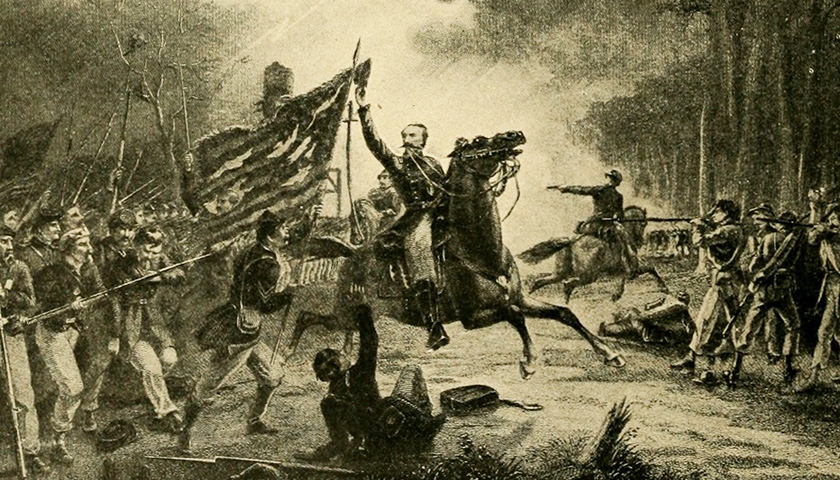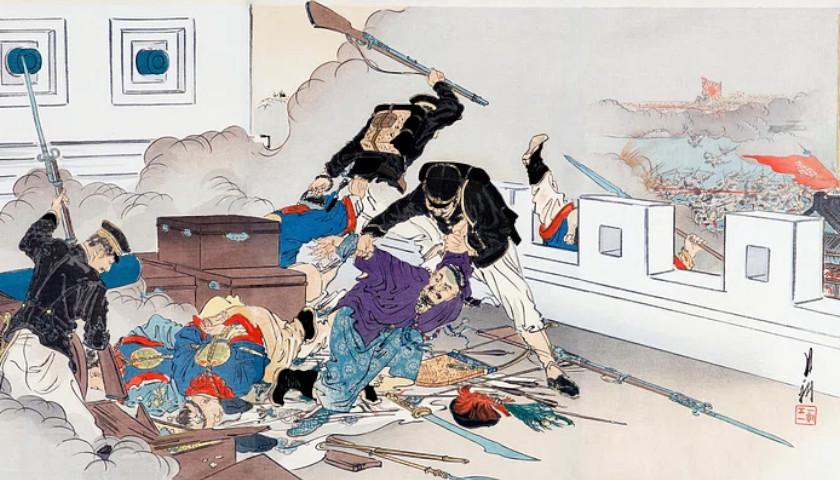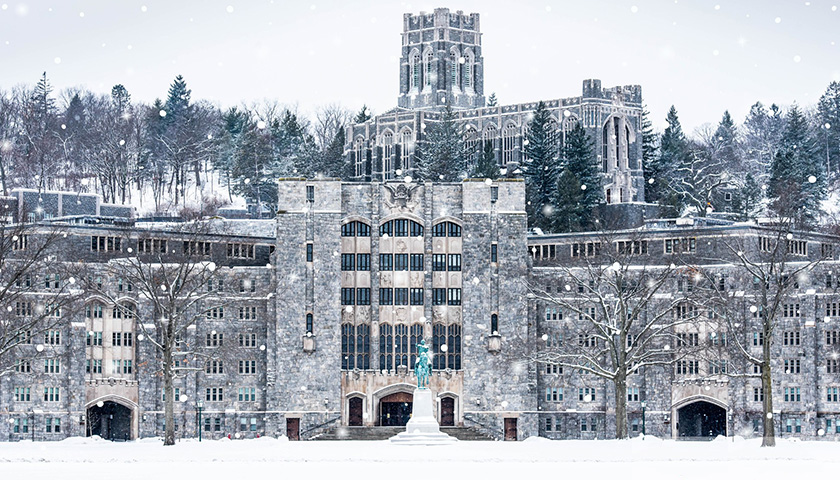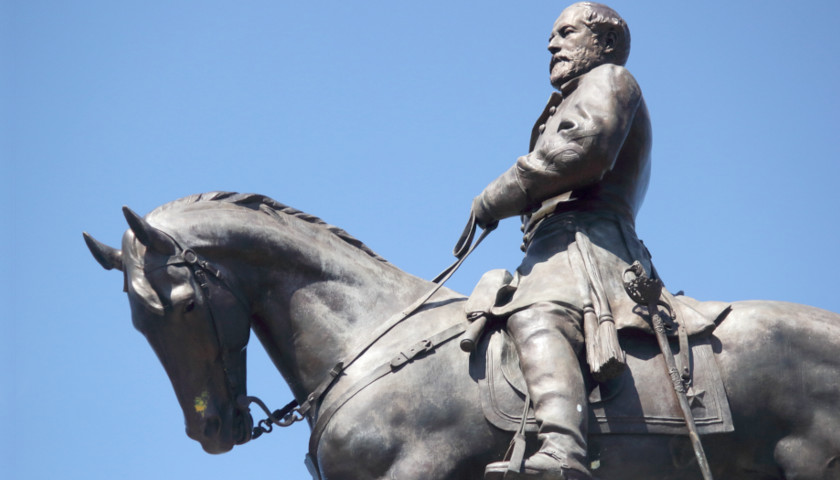by Mackubin Owens
Robert E. Lee’s smashing victory against Major General Joseph Hooker’s Army of the Potomac at Chancellorsville in May 1863 provided the Confederacy with three strategic options: shift resources from Virginia to Mississippi in order to revive Vicksburg, the Rebel redoubt on the Mississippi River; reinforce Braxton Bragg’s Army of Tennessee, enabling him to reprise his 1862 invasion of Kentucky and maneuver the Union Army of the Cumberland under William Rosecrans out of its position in central Tennessee; or invade Pennsylvania.
But after Chancellorsville, it was probably too late to affect the outcome at Vicksburg, because the siege was already under way. (Vicksburg would fall on the Fourth of July.) And it didn’t make sense to detach forces from the Confederacy’s only successful field army, the Army of Northern Virginia, under its only successful general, Lee, and send them to other generals whose competence was questionable. In the end, Lee effectively made the case to Confederate president Jefferson Davis that the best use of limited Confederate resources was to invade Pennsylvania. As he had done in the fall of 1862, Lee intended to effect a strategic turning movement, draw the Yankees out of Virginia, and annihilate a Federal army on Union soil, forcing Lincoln to sue for peace.
After the Seven Days’ Battles on the Virginia Peninsula in June 1862, Lee had organized his Army of Northern Virginia into two corps, the first commanded by General James Longstreet and the second by General Thomas Jonathan “Stonewall” Jackson. After Jackson’s death at Chancellorsville, Lee reorganized the army into three corps: I Corps under Longstreet, II Corps under James Ewell, and III Corps under Ambrose Powell Hill. The latter two had been excellent division commanders. However, their elevation to corps command was an example of the “Peter Principle” at work: promotion to a level above one’s competence. Lee would sorely miss Jackson in Pennsylvania.
The Campaign Begins
On June 3, Lee slipped out of his base at Fredericksburg and headed west into the Valley of Virginia. Ewell led the way, with Hill and Longstreet in trace. Unsure of Lee’s intentions, General Joseph Hooker, commanding the Union Army of the Potomac, ordered his cavalry commander, General Alfred Pleasonton, to conduct a reconnaissance across the Rappahannock. On June 9, Pleasonton’s cavalry surprised Jeb Stuart at Brandy Station. The ensuing battle was the largest all-cavalry engagement of the war. Although the Yankees were eventually driven from the field, the battle embarrassed Stuart. It also illustrated the strides made in the quality of Union cavalry under Hooker. But perhaps most important, it alerted Hooker to Lee’s movement north.
On June 13, Hooker began to move north in an attempt to keep his army between Lee and the Federal capital. The next day, Ewell routed a Federal force at Winchester, and on June 15, Lee crossed the Potomac. During his 1862 invasion of Maryland, Lee’s operational plan had been disrupted by unexpected resistance on the part of the Union garrison at Harpers Ferry. This time, Lee ignored it, heading directly north from the Shenandoah Valley into the Cumberland Valley of Maryland west of South Mountain
From the beginning of the campaign, Lee was unsure of the precise location and disposition of Hooker’s army. Stuart’s cavalry was supposed to provide such information, screening Lee’s advance into Pennsylvania, operating east of Blue Ridge between Lee and Hooker, and finally reuniting with Lee around York, Pennsylvania. Unfortunately for Lee, the encampment of the Army of the Potomac lay astride the route Stuart was to follow, forcing the latter to swing farther to the east, thereby placing Hooker between Lee and Stuart’s cavalry, which could not provide Lee with the location of the Union army.
For the next week, Stuart was unable to “turn the corner” because the Army of the Potomac was moving much faster than it had in the past. The main reason for this was that Hooker had reduced its baggage train.
On June 28, Hooker threatened to resign if his demand to assume control of the Harpers Ferry garrison was rejected. The general in chief, Henry Halleck, accepted Hooker’s resignation, much to the latter’s surprise, and replaced him with George Meade, a Pennsylvanian who had formerly commanded the Union V Corps.
All Roads Lead To Gettysburg
A glance at a map of south-central Pennsylvania reveals that “all roads lead” to Gettysburg. The town resembles the hub of a wheel with spokes converging from all directions: from the southwest, the Hagerstown Road; from the northwest, the Cashtown Pike; from the north-northwest, the Mummasburg Road; from the north, the Carlisle Road; from the northeast, the Harrisburg Road; from the east, the Bonaughtown Road and the York Pike; and from the south, the Emmitsburg Road, Taneytown Road, and Baltimore Pike.
Each of the two armies was operating in ignorance of the other’s location, but on June 30, Lee ordered Ewell to move south from Carlisle, and Hill to move east from Cashtown.
Meade’s plan was to assume a defensive position behind Pipe Creek in Maryland, just south of the Pennsylvania line. But Major General John Reynolds, commanding the Army of the Potomac’s I Corps, ignored the “Pipe Creek Circular” and moved northeast to occupy Gettysburg. The earliest Reynolds could do so was mid-morning of July 1, so on the evening of June 30, John Buford’s cavalry division moved into position on the high ground west of town to hold on until Reynolds’ arrival.
Stuart’s absence was a severe handicap for Lee. He discovered the proximity of the Union army only because of information provided by a spy that Longstreet had hired. But once he got a sense of the enemy’s location, Lee adopted a characteristically aggressive concept of operations. He wrote to Major General Isaac Trimble, “I shall throw an overwhelming force on their advance, crush it, follow up the success, drive one corps back on another, and by successive repulses and surprises before they can concentrate, create a panic and virtually destroy the [Army of the Potomac].”
Still, Lee wished to avoid a general engagement until he had concentrated his army. Although two of his corps were converging on Gettysburg from the north and the west, Longstreet would not be up until late the next day. But as Napoleon is reputed to have remarked, “A dogfight can initiate a battle.” At 5:30 a.m. on the morning of July 1, the lead element of Hill’s corps (Henry Heth’s division), approaching from the west on the Cashtown Pike, clashed with Buford’s cavalry on McPherson’s Ridge west of town.
The Battle of Gettysburg was on. Meade now had no choice but to abandon his Pipe Creek defensive plan and push the Army of the Potomac north toward Gettysburg.
Heth’s division deployed from column into line and advanced against Buford’s dismounted troopers on McPherson’s Ridge. Despite being outnumbered, the cavalrymen, armed with repeating carbines, were able to deliver a high volume of fire and gave ground only grudgingly. Heth nonetheless pushed forward to McPherson’s Ridge, where he encountered Reynolds’ I Corps, which checked his advance. Around 10:30 a.m., Reynolds was killed by a Confederate sniper, and command of I Corps fell to Abner Doubleday. There followed a lull in the battle as I Corps redeployed to Seminary Ridge and both sides awaited reinforcements.
At about noon, Major General O. O. Howard’s XI Corps arrived and deployed to Doubleday’s right, facing north to deal with the approach of Ewell’s corps from Carlisle. Lee also reached the field about this time. Without intelligence from Stuart, Lee still did not know the full disposition of the Federal army. As he wrote to General Richard Anderson of Hill’s corps, “In the absence of report from [Stuart], I am in ignorance of what we have in front of us here. It may be the whole Federal Army or it may be only a detachment. If it is the whole Federal force, we must fight a battle here.”
At about 2:00 p.m., Rodes’ division of Ewell’s corps, joined by Heth, struck the right of the Federal I Corps. About an hour later, Jubal Early’s division of Ewell’s corps attacked down the Harrisburg Road, smashing the exposed right of the XI Corps, a repeat of that unfortunate corps’ experience two months earlier at Chancellorsville when Jackson’s attack had routed the corps and rolled up the entire Union line. The routed Federals retreated through Gettysburg to Cemetery and Culp’s Hills, the high ground south of the town. Meanwhile the Federal I Corps on Seminary Ridge also gave way before Hill’s assault.
Lee ordered Ewell to press the attack against the new Union position “if practicable.” Proving he was no Stonewall Jackson, Ewell declined. Meanwhile Major General Winfield Scott Hancock arrived on the field in advance of his approaching II Corps. Much to the consternation of Howard, who was senior to Hancock, the latter announced that Meade had ordered him to assume field command of the Union forces. Howard accepted the slight and worked with Hancock to strengthen the Union position while Hancock pressed Meade to bring up the rest of the Army of the Potomac as quickly as possible.
During the first day of battle, Lee had shattered two Union corps, inflicting 9,000 casualties, including 3,000 captured, while suffering 6,500 of his own. The Union I Corps alone lost some 5,700 soldiers, including 1,500 captured. Some units bore the brunt of the battle: for instance, the 24th Michigan, a regiment of the famed “Iron Brigade,” the only all-western brigade in the Army of the Potomac, lost 399 of its 496 soldiers. Although the Union position on Cemetery and Culp’s Hills was strong, the soldiers of the I and XI Corps were demoralized. Had Ewell proven to be as aggressive as Jackson, it is likely that the Confederates would have carried the Federal position on the evening of July 1.
Lee and Longstreet: On the Cusp of Victory
Both armies were reinforced during the evening of July 1. Longstreet arrived with two of his three divisions (George Pickett’s division was still a day’s march away), and three more Union corps reached the battlefield. (It should be noted that Union corps were about half the size of Confederate corps at that time.) The Union position began to assume the shape of a fishhook, with the barb and bend running west from Culp’s Hill to Cemetery Hill, and the shank running south along Cemetery Ridge toward two rises, Little Round Top and Round Top.
Encouraged by his success on the first day, Lee resolved to renew the attack on July 2. An early-morning reconnaissance revealed that the Union line extended about halfway down Cemetery Ridge, short of the high ground of Little Round Top. Lee ordered Longstreet to take his two present divisions under major generals John Bell Hood and Lafayette McLaws and attack the Union left.
While Ewell demonstrated against the Union right on Culp’s and Cemetery Hills, Longstreet, supported by a division of Hill’s corps on his left, was to deliver a flank attack on the Union line. However, Lee was informed that the Union line on Cemetery Ridge had been extended south, so he modified his original plan and directed Longstreet to attack en echelon from south to north.
While it seems to violate the principle of mass by attacking piecemeal, an echelon attack is designed to force the defender into mistakes by getting him to create gaps in his line while trying to plug others. Thus Longstreet was to take advantage of any opportunities to unhinge the entire Union position on Cemetery Ridge.
It took Longstreet some time to reach his line of departure. Accordingly, his attack did not begin until about 4:00 p.m. Just as Longstreet was about to initiate his assault, Hood informed him that the way was open to the Union rear if he could swing his division farther to the south. Although Longstreet had advocated such a move, he demurred because of the additional time it would take to execute it. “General Lee has ordered me to attack along the Emmitsburg Road,” he said, “and that is what I will do.”
Longstreet now initiated his echelon attack by releasing his rightmost division under Hood against the Union left. Major General George Sykes’ V Corps was just now arriving on the battlefield, and a brigade was rushed forward to occupy Little Round Top and a jumble of rocks known as Devil’s Den in order to secure the Union left. The leftmost regiment of the brigade was Colonel Joshua Chamberlain’s 20th Maine, whose desperate defense of Little Round Top is immortalized in Michael Shaara’s historical novel Killer Angels and in the film “Gettysburg,” which is based on the novel.
While Hood was attacking Little Round Top and wresting Devil’s Den from the Yankees, Longstreet launched the second phase of his echelon attack by releasing the right wing of McLaws’ division. As McLaws’ brigades advanced toward Cemetery Ridge, they encountered Major General Daniel “Democrat Dan” Sickles’ III Corps in a wheat field and peach orchard just east of the Emmitsburg Road. Earlier in the day, Sickles, dissatisfied with his position at the base of Cemetery Ridge, had advanced without orders to this location. In so doing, he not only formed a salient but also created a gap between his right and Hancock’s II Corps to his north. This was exactly the sort of mistake that an echelon attack was designed to exploit.
The fighting was brutal, but McLaws’ attack eventually unhinged the Union salient by sweeping the peach orchard and the wheat field. Meade and Hancock tried to stem the Confederate tide by feeding troops into the gap created by the destruction of Sickles’ corps, but they created weaknesses elsewhere in the Union line. The echelon attack was on the cusp of success when it broke down, just as Major General William Pender’s division from Hill’s corps was to take it up. For some reason, his rightmost brigade refused the order to advance. Despite what Longstreet called “the best three hours’ fighting done by any troops on any battlefield,” the attack ground to a halt.
One episode stands out on the second day at Gettysburg. At the height of the fighting, Cadmus Wilcox’s fresh Alabama brigade of 1,500 men, pursuing the shattered remnants of Sickles’ corps, was on the verge of penetrating the Union defenses on Cemetery Ridge. Union commanders including Hancock rushed reinforcements forward to plug the gap, but at a critical juncture, the only available troops were eight companies—262 men—of the First Minnesota Volunteers. Pointing to the Alabamans’ battle flags, Hancock shouted to the regiment’s colonel, “Do you see those colors? Take them.”
As the First Minnesota’s colonel later related, “Every man realized in an instant what that order meant—death or wounds to us all; the sacrifice of the regiment to gain a few minutes’ time and save the position, and probably the battlefield—and every man saw and accepted the necessity for the sacrifice.”
The Minnesotans did not capture the colors of the Alabama brigade, but the shock of their attack broke the Confederates’ momentum and bought critical time—at the cost of 215 killed and wounded, including the colonel and all but three of his officers. The position was held, but in short order the First Minnesota ceased to exist, suffering a casualty rate of 82 percent, the highest of the war for any Union regiment in a single engagement. All told, some 9,000 troops on each side became casualties on July 2.
That evening, Meade called his corps commanders to his headquarters and polled them regarding a possible pull back to the Pipe Creek line. Meade seems to have preferred withdrawal but most of his commanders favored standing and fighting. “Let us have no more retreats,” advised Hancock.
The Third Day: “Pickett’s Charge”
In 1877, a former Confederate colonel in the Army of Northern Virginia, Armistead Lindsay Long, wrote that “the attack of Pickett’s division on the third [of July] has been more criticized, and is still less understood, than any other act of the Gettysburg drama.” What was true then remains true today. Why did Lee launch an attack that today seems to be nothing short of a senseless waste of life?
First, Lee had a great deal of confidence in the offensive power and élan of the Army of Northern Virginia. As Napoleon observed, “In war, moral considerations account for three-quarters, the balance of actual forces only for the other quarter.” And as Henry Heth, the only officer in the army whom Lee addressed by his surname, later wrote, “The fact is, General Lee believed the Army of Northern Virginia, as it then existed, could accomplish anything.”
Critics then and now have contended that Lee failed to recognize the power of the defense. But in fact, the relationship between the offense and the defense depends a great deal on the élan and striking power of the attackers. Hooker, who as both a corps commander and an army commander had experienced the offensive prowess of the Army of Northern Virginia, remarked that Lee’s army did not merely attack but struck with “blows.” “The shock seemed to make the earth tremble on which we stood,” he observed. The remarkable offensive striking power of Lee’s army resulted from its outstanding regimental-level leadership and morale, which translated into very high volumes of fire in the attack.
Second, although he had come close on the two previous days, Lee had not yet achieved his objective of destroying the Army of the Potomac, the reason he had invaded Pennsylvania to begin with. Third, Lee faced a logistics problem—a shortage of forage for the army’s animals as local supplies dried up. Two stationary armies quickly strip an area bare. Lee could not afford to remain in place for any length of time.
Finally, Lee believed he had inflicted a great deal of damage on the Army of the Potomac. Indeed he had. He had shattered three Union corps—Doubleday’s I, Sickles’ III, and Howard’s XI—and mauled many other regiments. On July 2, his forces had penetrated the Union line at several points. As Scott Bowden and Bill Ward observe in their excellent treatment of Gettysburg, Last Chance for Victory: Robert E. Lee and the Gettysburg Campaign—a book that has greatly influenced my understanding of Lee’s invasion of Pennsylvania—“only a breakdown in the [July 2] echelon attack’s execution had spared Meade a disastrous nighttime retreat and defeat.”
In addition, Lee had received fresh troops during the evening of July 2: Pickett’s division of Longstreet’s corps had arrived, and Jeb Stuart’s cavalry had finally been able to rejoin the army. Lee believed that Meade had weakened his center to reinforce his flanks. Under the circumstances, Lee believed, not unreasonably, that a concerted infantry attack, led by his ablest corps commander, and preceded by a massive artillery bombardment, could crack the Union center on Cemetery Ridge. Lee had seen his soldiers accomplish such a feat—without artillery support—during the Seven Days’ Battles of June 1862, when the Confederates cracked a strong Union position at Gaines’ Mill.
Lee’s plan for July 3 called for demonstrations against the Union flanks, the main attack to be made by Pickett’s fresh division and brigades for two of Hill’s divisions against the “hinge” in the Federal line on Cemetery Ridge. Although there is no hard evidence to suggest that Lee was familiar with it, Napoleon III’s victory against the Austrians at Solferino in 1859 constituted a precedent.
Two events created problems for Lee. First, Meade preempted Lee’s attack just before dawn on July 3 by launching an attack to dislodge those elements of Ewell’s corps that had gained a foothold on Culp’s Hill. Second, Longstreet had planned a maneuver that did not conform to Lee’s orders to him concerning the plan of attack on July 3. Longstreet was planning to “pass around [Round Top] and to gain [the Federal position] by flank and reverse attack.” But two brigades of Sedgwick’s VI Corps were already in position across the Taneytown Road to prevent just such a maneuver.
This was part of Longstreet’s grand vision for the Pennsylvania invasion. Indeed, Longstreet had proposed that, once in Pennsylvania, Lee should maneuver his army in order to find and occupy a strong defensive position that would require Meade to attack Lee. But this was never a serious option. While Lee knew northern Virginia like the back of his hand, he was unfamiliar with the military geography of Pennsylvania. He had to avoid cutting himself off from the Cumberland Valley, which constituted his only line of communication and supply back to Virginia.
Although it has gone down in history as “Pickett’s Charge,” the attackers on July 3 included elements of two divisions from Hill’s corps—those of Major General Isaac Trimble and of Brigadier General J. J. Pettigrew, who had replaced the wounded Henry Heth. Indeed, Pickett’s Virginians provided only three of the nine brigades that made the assault. The attackers would have to cross nearly 2,000 yards under enemy fire. They would have to climb over a rail fence along the Emmitsburg Road, an obstacle that would break the momentum of the attack. From that point, depending on where they crossed the Emmitsburg Road, the attacking Confederates would have to advance another 200 to 500 yards to reach the Union position. As they advanced, their ranks would be ripped apart by musket fire and artillery.
As we know, the attack failed. As had been the case the previous day, Ewell was effectively AWOL. A weak cavalry demonstration against the Union rear was beaten back. And the main attack on Cemetery Ridge was repulsed, with staggering losses for the Confederates. Nonetheless, a small number of Rebels led by one of Pickett’s brigade commanders, Lewis Armistead, penetrated the Union line. By this time, the attack had lost momentum and lacked any support, so the survivors withdrew, leaving behind the mortally wounded Armistead. Nearly 5,600 of the 12,000 attackers became casualties.
Gettysburg remains the greatest battle ever to occur on the North American continent. Meade suffered some 23,000 casualties over the course of the battle, while Lee lost between 20,000 and 25,000 of his irreplaceable soldiers. On July 5, Lee moved south. Meade did not pursue the Rebels, much to the consternation of President Lincoln. But Meade was in no condition to pursue. The Army of the Potomac was only in marginally better shape than the Army of Northern Virginia. As the Duke of Wellington observed, “The only thing worse than a battle won is a battle lost.”
– – –
Mackubin Thomas Owens is a retired Marine, professor, and editor who lives in Newport, RI.
Photo “The Battle of Gettysburg” by Internet Archive Book Images. CC0 1.0.





